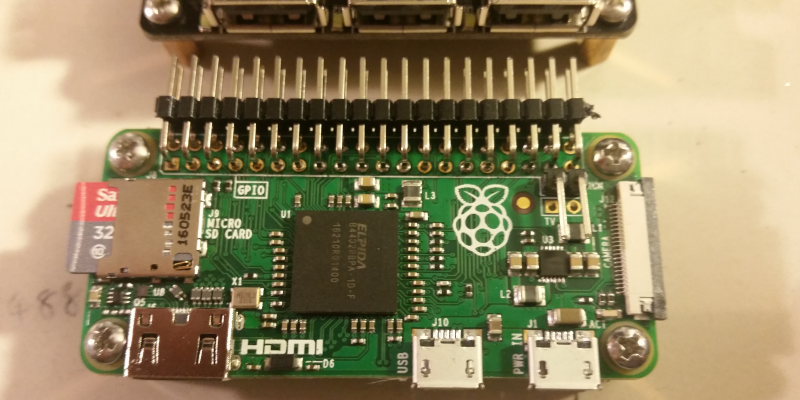There are many uses for an old 10 Mbps Ethernet hub besides using it as a speed-bump in your network. (No fun in that!) [thinkerzone] decided to gut an old EN104 Bay Networks ‘Netgear Hub’ to re-purpose the solid steel case as a Raspberry Pi Zero PC housing. The project, which [thinkerzone] called Pikelet, aims to be an ‘IoT server’ with the feel of a PC. Note: a PC, not a Gameboy. In his hackaday.io project, he describes the minimum set of features for the Pikelet.
- Power button – PCs need a power button
- Power and Status LEDS – Blue for power, RGB for the programmable status LED
- USB ports – using a Zero4U hub to expand the Pi Zero usb ports
- Ethernet – using a ENC28J60 module was the original idea, but it burned while making the project
- HDMI access – the case should ensure the HDMI port is accessible
- Minimum storage – a 32 Gb SD card was found to be “enough to be useful”
- UART – via a FT232 module
- WiFi – a WiFi dongle with an external antenna, since the metal case would degrade the signal if it was inside, so a WiFi hat was not an option
On the software side, it runs the latest version of Raspbian with some additional configuration for the UART port and status LED pins.
In the project logs we can follow along as [thinkerzone] battles through the implementation of the project and, well, Murphy’s Law. One of the things that a descriptive log is useful for is that it serves as a reminder that an apparently simple project can have a lot of setbacks. Sometimes an easy-to-describe project is quite a challenge to implement. And it can be annoying when explaining the challenges to other (non hackers/makers) persons and they go: “That’s just connecting some wires…”
Is the feeling familiar? It’s nice to see someone else going through it too.
















Nice! Though the software support is the usual problem with those kind of projects, and the case could benefit from some laser-cut panels. Also, the SDIO WiFi way is still possible, you just need to pick a ESP8266 module with an uFL connector. Though, seeing the 4 USB ports, this is not such of a problem.
> UART – via a FT232 module
But why? The Pi has an exposed UART! You do get guaranteed 5V tolerance I guess.
From what I’ve understood, he’s using it as a quick way to issue commands to the Pi – if something fucks up, plug in the USB from your laptop and debug why, instead of opening the case and searching for the right UART pins. He could have also used pyLCI, though.
The golden use for that old ehternet hubs: Traffic analisys, no special drivers, cables, or dual network cards
I agree with the BOM except the SD card I think 16gb is enough for *most* Pi projects but it depends on your usage I suppose.Not much of a saving but hey every penny/cent counts.
Nice to see others upcycling those old switch/hub boxes
I have already built a server in an old metal Ethernet hub box.
1tb HDD over USB-to-Sata.
reused a 100Mb/s mini switch.
Built a surge-isolation decoupling power distribution as the pi would crash the switch and the pair would glitch/crash when and each time the HDD spins up.
Not yet got the power button, HDMI or status lights fitted yet, so thinkerzone’s project is already ahead of mine by the seems of it. My server is already in constant use * thus hindering further progress.
*work borrowing it, kept it in my work-space, even though it is my property, they are too lazy to clone it just because it is not running windows, if and when I decide to change my job-path I can legally take it, lol
Oh, forgot..
my server is for PXE + disk image storage.
and the whole lot uses no more than 6W max load.
Stop using “upcycle”.
I’ll bear that in mind for the future and use “up-cycle” instead of “upcycle”.
I’m going to start using it.
I use upcycle as a half-way meaning between recycle and reuse with a hint at it being better in some way (upgrade)
I use said word when I don’t quite know the appropriate word to use.
I do like projects like this, but can’t help thinking that…. maybe instead of the RPi Zero, he might’ve been better off with one of the Orange Pi models. I’m playing with the <$10 Orange Pi Zero which already has an ethernet port, one full-size USB (and headers for two more) and onboard wifi. Only real downside to the OPi Zero over the RPi Zero in this case is it doesn't have HDMI-out.
Just kind of shows the variety we now have with extremely low-cost SBCs, which is kind of great.